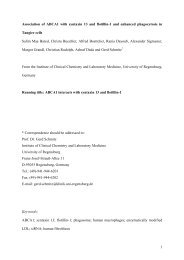SUNDAY, DECEMBER 4- Late Abstracts 1 - Molecular Biology of the ...
SUNDAY, DECEMBER 4- Late Abstracts 1 - Molecular Biology of the ...
SUNDAY, DECEMBER 4- Late Abstracts 1 - Molecular Biology of the ...
You also want an ePaper? Increase the reach of your titles
YUMPU automatically turns print PDFs into web optimized ePapers that Google loves.
2043<br />
The Drosophila Transcription Factor Protein Interactome.<br />
D. Y. Rhee 1 , B. Zhai 1 , C. Wong 1 , C. Beekman 1 , S. Gygi 1 , R. Obar 1 , S. Artavanis-Tsakonas 1 ;<br />
1 Department <strong>of</strong> Cell <strong>Biology</strong>, Harvard Medical School, Boston, MA<br />
<strong>SUNDAY</strong><br />
From <strong>the</strong> earliest embryo to <strong>the</strong> adult, <strong>the</strong> spatiotemporal expression <strong>of</strong> genes is essential for<br />
normal development and physiology. At <strong>the</strong> basis <strong>of</strong> this is <strong>the</strong> regulation <strong>of</strong> transcription via<br />
transcription factors (TFs), proteins that physically bind DNA to activate or suppress gene<br />
expression. As <strong>the</strong> target <strong>of</strong> signaling pathways, TFs represent a crucial point <strong>of</strong> regulation<br />
relating to <strong>the</strong> vast majority <strong>of</strong> cellular processes and as a rule function through interactions with<br />
o<strong>the</strong>r proteins. Consequently, <strong>the</strong> characterization <strong>of</strong> protein-protein interactions involving TFs is<br />
essential for understanding how <strong>the</strong>y function to regulate gene expression and, in turn, <strong>the</strong><br />
biology <strong>of</strong> <strong>the</strong> cell. Towards this end, we have generated a co-AP/MS-based interaction map<br />
encompassing more than 500 from <strong>the</strong> total <strong>of</strong> 750 TFs estimated, by various criteria, to<br />
represent <strong>the</strong> entire gamut <strong>of</strong> TFs in Drosophila melanogaster.<br />
Cell Migration and Motility<br />
2044<br />
Macrophage Strength: Quantifying Phagocytic Forces and Kinetics.<br />
N. Sosale 1 , T. Rouhi 2 , P. Rodriguez 1 , R. Lipowsky 2 , D. Discher 1 ; 1 Biophysical Engineering Lab,<br />
University <strong>of</strong> Pennsylvania, Philadelphia, PA, 2 Max Planck Institute <strong>of</strong> Colloids and Interfaces,<br />
Potsdam, Germany<br />
Macrophages act as immunological gatekeepers at <strong>the</strong> interface <strong>of</strong> tissue, blood, and lymph as<br />
<strong>the</strong>se cells take up antigens from <strong>the</strong> extracellular environment and <strong>the</strong>n present <strong>the</strong>m to <strong>the</strong><br />
immune system stimulating lymphocytes. We have studied <strong>the</strong> force and kinetics <strong>of</strong><br />
phagocytosis by human macrophages. To this aim, we studied phagocytosis <strong>of</strong> opsonized red<br />
blood cells. The force calculation is based on blood cell's shape deformation and elastic<br />
properties. Our analysis shows that <strong>the</strong> range <strong>of</strong> <strong>the</strong> resultant force imposed by Macrophages is<br />
up to 100 pN and is imparted within 10 minutes after initial contact.<br />
2045<br />
Integrin Linked Kinase Modulates Phagocytosis through Rac1 Activation in Epidermal<br />
Keratinocytes.<br />
S. Sayedyahossein 1,2 , L. Nini 1 , L. Dagnino 1,2 ; 1 Physiology and Pharmacology, The University <strong>of</strong><br />
Western Ontario, London, ON, Canada, 2 Children’s Health Research Institute, London, ON,<br />
Canada<br />
Integrin linked kinase (ILK) is an adaptor protein that regulates numerous biological processes,<br />
such as cell survival and migration. ILK is also essential for keratinocyte interactions with <strong>the</strong><br />
extracellular matrix and development <strong>of</strong> polarity, but <strong>the</strong> exact role <strong>of</strong> ILK in o<strong>the</strong>r epidermal<br />
functions, such as melanosome phagocytosis, is not clear. We examined alterations in<br />
phagocytic capacity in ILK-deficient epidermal keratinocytes, using 0.5-µm latex microspheres.<br />
Inactivation <strong>of</strong> <strong>the</strong> Ilk gene resulted in severe impairment <strong>of</strong> microsphere uptake. Fur<strong>the</strong>r,<br />
stimulation <strong>of</strong> <strong>the</strong> keratinocyte growth factor (KGF) receptor or PAR-2 failed to increase<br />
phagocytosis in <strong>the</strong>se cells. Activation <strong>of</strong> ERK in response to KGF stimulation is unaltered in<br />
ILK-deficient keratinocytes, indicating that <strong>the</strong> KGF receptor likely signals normally in <strong>the</strong><br />
absence <strong>of</strong> ILK. In contrast, ILK deficiency was associated with impaired Rac1 activation in<br />
response to KGF. The latter was accompanied by reduced formation <strong>of</strong> membrane ruffles and
















